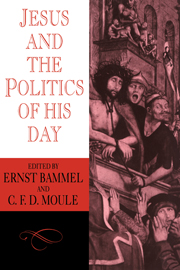Book contents
- Frontmatter
- Contents
- Abbreviations
- Foreword
- The Zealots and Jesus
- The revolution theory from Reimarus to Brandon
- The date and character of Mark
- Some observations on Tendenzkritik
- Argumentum e silentio
- The Poor and the Zealots
- The opposition between Jesus and Judaism
- Judaeo-Christianity and the Jewish establishment, A.D. 33–66
- A.D. 70 in Christian reflection
- The trial of Jesus in the Acta Pilati
- Christ as brigand in ancient anti-Christian polemic
- Jesus as a political agent in a version of the Josippon
- The Feeding of the Multitude
- The coin of ‘Render unto Caesar …’ (A note on some aspects of Mark 12: 13–17; Matt. 22: 15–22; Luke 20:20–26)
- Render to Caesar
- The Temple tax
- ‘Not peace but a sword’: Matt. 10:34ff; Luke 12: 51ff
- The decision of the Supreme Court to put Jesus to death (John 11:47–57) in its context: tradition and redaction in the Gospel of John
- The ‘triumphal’ entry
- The two swords (Luke 22: 35–38)
- The titulus
- Romans 13
- Biblical criticism criticised: with reference to the Markan report of Jesus's examination before the Sanhedrin
- The political charge against Jesus (Luke 23: 2)
- The trial before Pilate
- ‘His witness is true’: A test of the Johannine claim
- Index of Authors
- Index of References
Render to Caesar
Published online by Cambridge University Press: 19 January 2010
- Frontmatter
- Contents
- Abbreviations
- Foreword
- The Zealots and Jesus
- The revolution theory from Reimarus to Brandon
- The date and character of Mark
- Some observations on Tendenzkritik
- Argumentum e silentio
- The Poor and the Zealots
- The opposition between Jesus and Judaism
- Judaeo-Christianity and the Jewish establishment, A.D. 33–66
- A.D. 70 in Christian reflection
- The trial of Jesus in the Acta Pilati
- Christ as brigand in ancient anti-Christian polemic
- Jesus as a political agent in a version of the Josippon
- The Feeding of the Multitude
- The coin of ‘Render unto Caesar …’ (A note on some aspects of Mark 12: 13–17; Matt. 22: 15–22; Luke 20:20–26)
- Render to Caesar
- The Temple tax
- ‘Not peace but a sword’: Matt. 10:34ff; Luke 12: 51ff
- The decision of the Supreme Court to put Jesus to death (John 11:47–57) in its context: tradition and redaction in the Gospel of John
- The ‘triumphal’ entry
- The two swords (Luke 22: 35–38)
- The titulus
- Romans 13
- Biblical criticism criticised: with reference to the Markan report of Jesus's examination before the Sanhedrin
- The political charge against Jesus (Luke 23: 2)
- The trial before Pilate
- ‘His witness is true’: A test of the Johannine claim
- Index of Authors
- Index of References
Summary
In the context of Jesus's ministry in the outer court of the Temple during his last week in Jerusalem Mark (followed by the two other synoptic evangelists) records this incident:
They send to him some of the Pharisees and the Herodians to catch him in a statement. They come and say to him, ‘Teacher, we know that you are true and court no one's favour: you do not regard anyone's status, but teach the way of God truly. Is it permissible to give tribute to Caesar or not? Shall we give it, or shall we not give it?’ Knowing that they were acting a part he said to them: ‘Why do you try (to catch) me (like this)? Bring me a denarius; let me see it.’ They brought him one; and he says to them, ‘Whose image is this? Whose name is inscribed (on the coin)?’ ‘Caesar's’, said they. So Jesus said ‘Give Caesar's property back to Caesar; give God what belongs to God.’ They were lost in amazement at him.
While the point of the incident is preserved in all three synoptic records, it is generalised in later stages of the tradition. Thus, in Papyrus Egerton 2, it appears in the form:
They came to him and tested him with a question: ‘Master Jesus, we know that you have come from God, for the things which you do bear witness beyond all the prophets. […]
- Type
- Chapter
- Information
- Jesus and the Politics of his Day , pp. 249 - 264Publisher: Cambridge University PressPrint publication year: 1984
- 6
- Cited by

